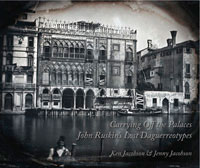Carrying Off the Palaces: John Ruskin's Lost Daguerreotypes
By Ken Jacobson & Jenny Jacobson
 The inspiration for this book was a remarkable discovery made by the authors at a small country auction in 2006. One lightly regarded lot was, in fact, a distressed mahogany box crammed with long-lost daguerreotypes - early photographs that had once belonged to John Ruskin, the great 19th-century art critic, writer, artist and social reformer. Assiduously taken, purchased or commissioned by Ruskin, the many scenes of Italy, France and Switzerland include the largest collection of daguerreotypes of Venice in the world and probably the earliest surviving photographs of the Alps. This trove has, at a stroke, more than doubled the number of Ruskin daguerreotypes extant.
He described his earliest views of Venice, acquired in 1845, with intense excitement: 'I have been lucky enough to get ... some most beautiful, though small, Daguerreotypes of the palaces I have been trying to draw ... glorious things. It is very nearly the same thing as carrying off the palace itself ...' Ruskin's Venetian daguerreotypes became invaluable records for The Stones of Venice, his epic 3-volume documentation of the city, published 1851-1853.
The inspiration for this book was a remarkable discovery made by the authors at a small country auction in 2006. One lightly regarded lot was, in fact, a distressed mahogany box crammed with long-lost daguerreotypes - early photographs that had once belonged to John Ruskin, the great 19th-century art critic, writer, artist and social reformer. Assiduously taken, purchased or commissioned by Ruskin, the many scenes of Italy, France and Switzerland include the largest collection of daguerreotypes of Venice in the world and probably the earliest surviving photographs of the Alps. This trove has, at a stroke, more than doubled the number of Ruskin daguerreotypes extant.
He described his earliest views of Venice, acquired in 1845, with intense excitement: 'I have been lucky enough to get ... some most beautiful, though small, Daguerreotypes of the palaces I have been trying to draw ... glorious things. It is very nearly the same thing as carrying off the palace itself ...' Ruskin's Venetian daguerreotypes became invaluable records for The Stones of Venice, his epic 3-volume documentation of the city, published 1851-1853.
Despite his sometimes vehemently negative sentiments regarding the camera, Ruskin never stopped using photography. Patient scholarship has revealed the extent to which daguerreotypes aided the creation and influenced the style of his watercolours; his wide circle of friends and colleagues who used the camera; his dogged collecting and commissioning of photographs; and how he pioneered the use of the collotype and platinotype processes for book illustration.
The authors have included a fully illustrated and informative catalogue raisonné of 325 known Ruskin daguerreotypes. The overwhelming majority of the newly-discovered plates are published here for the first time. There are an additional 275 illustrations in the text and an essay describing the procedures used in a remarkably successful conservation programme. This work is by some way the most extensive study of Ruskin's photographic endeavours. The beautiful illustrations reveal the full range of Ruskin's subject matter from serene Venetian canal scenes to intricate architectural detail and semi-abstract geological studies. The quality and unorthodox style of many of Ruskin's daguerreotypes will come as a major revelation to both photographic historians and Ruskin scholars.
There are 432 pages and 601 illustrations in this hardback volume.
